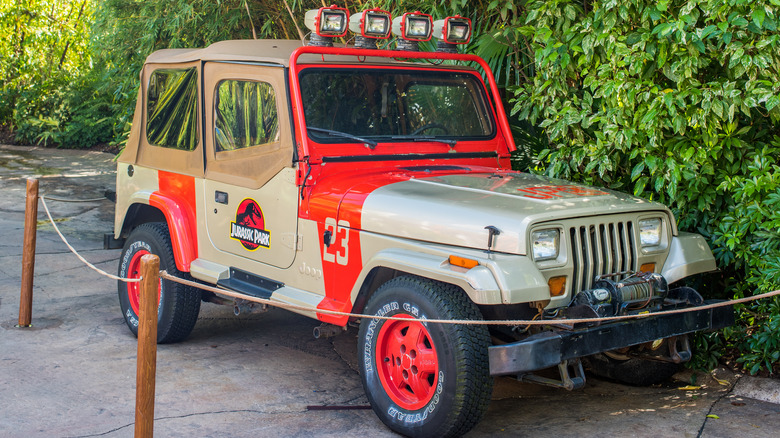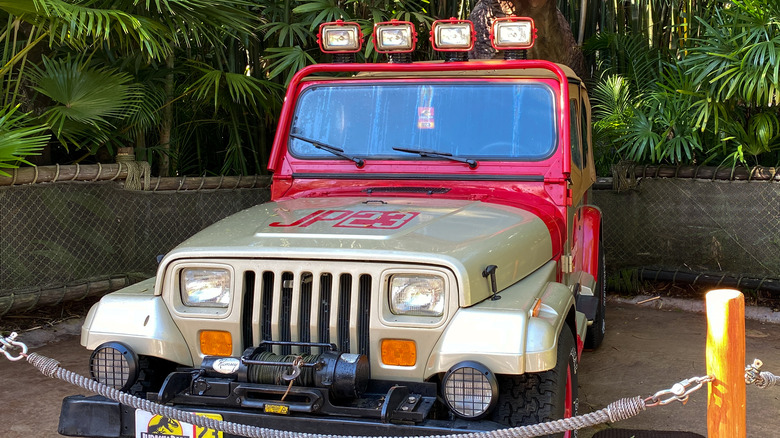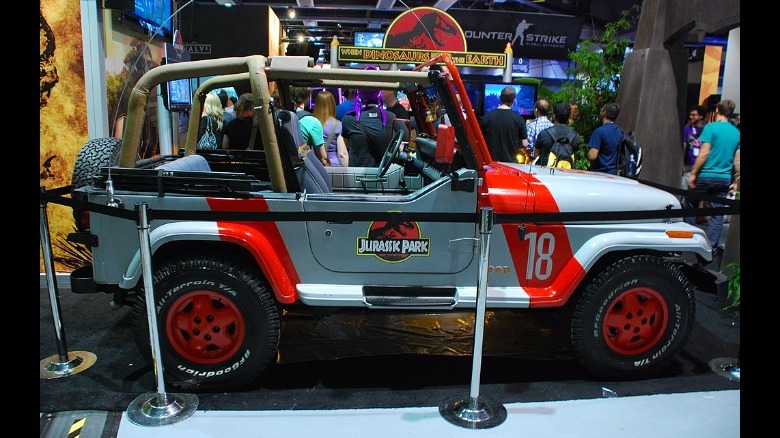Everything Jeep Fans Should Know About The Wrangler YJ From Jurassic Park
The 1993 film "Jurassic Park" was a massive critical and commercial success, displacing another Spielberg film, "E.T. the Extra-Terrestrial" as the then-highest-grossing film of all time. It also rekindled a healthy interest in dinosaurs among young and old alike. Alongside its human stars like Sam Neill and Laura Dern, two vehicles placed prominently in the film's plot — Ford's Explorer SUV and the iconic Jeep Wrangler used by the park's staff.
The Wranglers in "Jurassic Park" are first-generation models, called the YJ, which replaced the venerable Jeep CJ in 1987 and continued production through 1995. Wrangler YJs are easily identifiable by their highly controversial rectangular headlights instead of the conventional round headlights used in every other CJ and Wrangler. All of the Jeeps used in "Jurassic Park" were 1992 models with the upscale Sahara trim package, as evidenced by fender flares painted body color, side steps, and green interiors, all exclusive to the Sahara. The paint color is factory Sand Beige which, interestingly, was only available for a single year, 1992.
Of course, the film crew spiced up the tan Jeeps with copious amounts of red accent stripes and red-painted aluminum wheels. The red wheels were then shod in the gold standard for off-road tires, the BF Goodrich All-Terrain T/A. These tires are still produced today, although the design has grown a lot more sophisticated over time. The Sahara trim level on which the Jurassic Jeeps were based only came equipped with one engine, a reliable 4.0 liter "high output" inline-6 cylinder that made 190 horsepower. Some of the Jeeps are clearly shown on screen with a five-speed manual transmission, but it's unknown if any automatics made it into the mix.
There were 5 different Jeeps in the film
In total, five different Wranglers are used by the park staff, all uniquely numbered. These five vehicles are customized to varying degrees, with all having a front-mounted electric winch, but only some having a brace of off-road searchlights. One of the most prominent Wranglers in the film, number 10, is without its factory roll cage, presumably removed by the film crew for effect.
Speaking of roll cages, the YJ's tubular roll cage was significantly redesigned for 1992. Instead of the traditional triangular support bars that angle down into the rear seat area, 1992 and later YJs have what's called a "family" roll cage (below) that's boxier in shape. Although the family roll cage doesn't look as sleek as the prior design, protection for rear seat passengers is superior. Therefore, the many fans of the film and/or Jeep enthusiasts who build replicas of the Jurassic Wranglers tend to avoid models older than 1992 because the roll cage is so visually different.
The original Jurassic Park film spawned many sequels in which Jeep's timeless Wrangler continued to play a role. In 2022, Jeep even launched a television commercial tied to "Jurassic World Dominion," which featured a baby dinosaur riding in the back seat of its Wrangler 4xe hybrid. But it all started with the oft-maligned YJ.
[Embedded image by rebelcan via Wikimedia Commons | Cropped and scaled | CC BY-SA 2.0]


